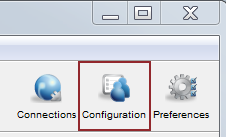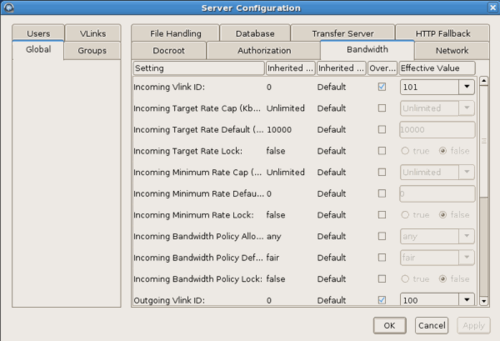Bandwidth Configuration
The Bandwidth configuration options include target transfer rates, transfer policies, and assigning vlinks to control aggregate bandwidth usage.
- Open the application with root privileges.
- Click Configuration > Bandwidth.


- Edit Global , Groups, and Users settings on their Bandwidth tabs. Select Override in the option's row to set an effective value. User settings take precedence over group settings, which take precedence over global settings.
Bandwidth Settings Reference
| Field | Description | Values | Default |
|---|---|---|---|
| Incoming Vlink ID | The ID of the vlink to apply to incoming transfers. Vlinks are a way to define aggregate transfer policies. For more information, see Controlling Bandwidth Usage with Virtual Links (GUI) or Controlling Bandwidth Usage with Virtual Links (Command Line). | Vlink IDs | Undefined (Disabled) |
| Incoming Target Rate Cap (Kbps) | The maximum target rate for incoming transfers, in kilobits per second. No transfer session can exceed this rate at any time. If the client requests an initial rate greater than the target rate cap, the transfer proceeds at the target rate cap. The default setting of unlimited applies no target rate cap. | positive integer | unlimited |
| Incoming Target Rate Default (Kbps) | The default initial rate for incoming transfers, in kilobits per second. If allowed
("Incoming Target Rate Lock" is set to false), clients can
modify this rate in real time. This setting is not relevant to transfers
with a fixed bandwidth policy. |
positive integer | 10000 |
| Incoming Target Rate Lock | Lock the target rate of incoming transfers to the default value (set to true). Set to false to allow users to adjust the transfer rate of an incoming transfer up to the "Incoming Target Rate Cap". | true or false | false |
| Incoming Minimum Rate Cap (Kbps) | The highest minimum rate that an incoming transfer can request, in kilobits per
second. Client minimum rate requests that exceed the minimum rate cap are
ignored. The default value of unlimited applies no cap to the
minimum rate. Important: Aspera strongly
recommends setting the minimum rate cap to zero. Transfers do not slow
below the client's requested minimum rate unless the minimum rate is
capped on the server. If the client-requested minimum rate exceeds
network or storage capacity, this can decrease transfer performance and
cause problems on the target storage. |
positive integer or unlimited | unlimited |
| Incoming Minimum Rate Default (Kbps) | The default initial minimum rate for incoming transfers, in kilobits per second. If
allowed ("Incoming Minimum Rate Lock" is set to false),
clients can modify the minimum rate in real time, up to the "Incoming
Minimum Rate Cap". This setting is not relevant to transfers with a
fixed bandwidth policy. |
positive integer | 0 |
| Incoming Minimum Rate Lock | Lock the minimum rate of incoming transfers to the default value (set to
true). Set to false to allow users to adjust the minimum
transfer rate up to the "Incoming Minimum Rate Cap". This setting is not
relevant to transfers with a fixed bandwidth policy. Important: Aspera strongly recommends setting a
lock on minimum rate to prevent transfers from using minimum rates that
can overwhelm network or storage capacity, decrease transfer
performance, and cause problems on the target storage. |
true or false | false |
| Incoming Bandwidth Policy Allowed | The bandwidth policies that incoming transfers can use. Aspera transfers can use high,
fair, low, or fixed bandwidth policies to determine bandwidth allocation
among transfers.
|
high, fair, low, or any | any |
| Incoming Bandwidth Policy Default | The default bandwidth policy for incoming transfers. Clients can override the default
policy if they specify a policy allowed by the server (see "Incoming
Bandwidth Policy Allowed") and if "Incoming Bandwidth Policy Lock" is set to
false.
|
high, fair, low, fixed | fair |
| Incoming Bandwidth Policy Lock | Lock the bandwidth policy of incoming transfer sessions to the default value (set to true). Set to false to allow users to adjust the bandwidth policy. | true or false | false |
| Incoming Rate Control Module |
Set how the transmission rate should be managed relative
to instantaneous network bandwidth availability. Aspera recommends that
this option be changed only by advanced users.
When the client does not specify a configuration, the server configuration is used. When the client specifies a value other than delay and the client is the receiver, then the client configuration overrides the server configuration. Values:
To set a rate control module for outgoing traffic, set it from the command line (aspera.conf - Transfer Configuration). |
delay, delay-odp, delay-adv, or delay-laq | delay |
| Incoming Traffic RTT Predictor | The type of predictor to use to compensate for
feedback delay when measuring RTT. An experimental feature that might
increase transfer rate stability and throughput by predicting network
congestion. When set to unset, the client-specified
predictor is used and if the client does not specify a predictor, then
none is used. For more information, see Increasing Transfer Performance by Using an RTT Predictor. |
unset, none,
alphabeta, fd31,
bezier, ets |
unset |
| Incoming Rate Control Target Queue | The method for calculating the target queue.
Static queuing is good for most internet connections, whereas dynamic
queuing is good for satellite and other radio connections. For more
information, see Increasing Transfer Performance by Using an RTT Predictor. When set to
unset, the client-specified transfer queuing method
is used and if the client does not specify a queuing method, then
static is used. |
unset,
static, dynamic |
unset |
| Outgoing Vlink ID | The ID of the vlink to apply to outgoing transfers. Vlinks are a way to define aggregate transfer policies. For more information, see Controlling Bandwidth Usage with Virtual Links (GUI) or Controlling Bandwidth Usage with Virtual Links (Command Line). | Vlink ID | Undefined (Disabled) |
| Outgoing Target Rate Cap (Kbps) | The maximum target rate for outgoing transfers, in kilobits per second. No transfer session can exceed this rate at any time. If the client requests an initial rate greater than the target rate cap, the transfer proceeds at the target rate cap. The default setting of unlimited applies no target rate cap. | positive integer | unlimited |
| Outgoing Target Rate Default (Kbps) | The default initial rate for outgoing transfers, in kilobits per second. If allowed
("Outgoing Target Rate Lock" is set to false), clients can
modify this rate in real time up to the "Outgoing Target Rate Cap". This
setting is not relevant to transfers with a fixed bandwidth
policy. |
positive integer | 10000 |
| Outgoing Target Rate Lock | Lock the target rate of outgoing transfers to the default value (set to true). Set to false to allow users to adjust the transfer rate of an outgoing transfer. | true or false | false |
| Outgoing Minimum Rate Cap (Kbps) | The highest minimum rate that an outgoing transfer can request, in kilobits per
second. Client minimum rate requests that exceed the minimum rate cap are
ignored. The default value of unlimited applies no cap to the
minimum rate. Important: Aspera strongly
recommends setting the minimum rate cap to zero. Transfers do not slow
below the client's requested minimum rate unless the minimum rate is
capped on the server. If the client-requested minimum rate exceeds
network or storage capacity, this can decrease transfer performance and
cause problems on the target storage. |
positive integer | unlimited |
| Outgoing Minimum Rate Default | The default initial minimum rate for outgoing transfers, in kilobits per second. If
allowed ("Outgoing Minimum Rate Lock" is set to false),
clients can modify the minimum rate in real time up to the "Outgoing Minimum
Rate Cap". This setting is not relevant to transfers with a fixed
bandwidth policy. |
positive integer | 0 |
| Outgoing Minimum Rate Lock | Lock the minimum rate of outgoing transfers to the default value (set to
true). Set to false to allow users to adjust the minimum
transfer rate. This setting is not relevant to transfers with a
fixed bandwidth policy. Important: Aspera strongly
recommends setting a lock on minimum rate to prevent transfers from
using minimum rates that can overwhelm network or storage capacity,
decrease transfer performance, and cause problems on the target
storage. |
true or false | false |
| Outgoing Bandwidth Policy Allowed | The bandwidth policies that outgoing transfers can use. Aspera transfers can use high,
fair, low, or fixed bandwidth policies to determine bandwidth allocation
among transfers.
|
high, fair, low, or any | any |
| Outgoing Bandwidth Policy Default | The default bandwidth policy for outgoing transfers. Clients can override the default
policy if they specify a policy allowed by the server (see "Outgoing
Bandwidth Policy Allowed") and if "Outgoing Bandwidth Policy Lock" is set to
false.
|
high, fair, low, fixed | fair |
| Outgoing Bandwidth Policy Lock | Lock the bandwidth policy of outgoing transfer sessions to the default value (set to true). Set to false to allow users to adjust the bandwidth policy. | true or false | false |
| Outgoing Traffic RTT Predictor | The type of predictor to use to compensate for
feedback delay when measuring RTT. An experimental feature that might
increase transfer rate stability and throughput by predicting network
congestion. When set to unset, the client-specified
predictor is used and if the client does not specify a predictor, then
none is used. For more information, see Increasing Transfer Performance by Using an RTT Predictor. |
unset, none,
alphabeta, fd31,
bezier, ets |
unset |
| Outgoing Rate Control Target Queue | The method for calculating the target queue.
Static queuing is good for most internet connections, whereas dynamic
queuing is good for satellite and other radio connections. For more
information, see Increasing Transfer Performance by Using an RTT Predictor. When set to
unset, the client-specified transfer queuing method
is used and if the client does not specify a queuing method, then
static is used. |
unset,
static, dynamic |
unset |